
Kung Fu 2100 is a board game published by Steve Jackson Games in 1980 that simulates martial arts combat.

Kung Fu 2100 is a board game published by Steve Jackson Games in 1980 that simulates martial arts combat.
Kung Fu 2100 is a martial arts microgame about combat that takes place in a future setting. [1] In a world ruled by the evil CloneMaster, Terminators have been trained in martial arts to end the CloneMaster's reign. One player controls the Terminators, the other controls the CloneMaster and his minions.
The microgame box contains [2]
The CloneMaster player places all of the CloneMaster's minions on the map facedown. [2]
Three scenarios are included with the game, including a solitaire game. In each scenario, three Terminators enter the fortress. Each turn consists of Terminator movement, attack and movement, followed by CloneMaster movement and attack. [2]
In combat, the Terminator player picks three skill counters and his opponent picks two. Each player puts down one counter, the attacker rolls a six-sided die, and the CRT is checked for that combination. Now the Clonemaster's first defensive counter becomes the CloneMaster's first attack. The Terminator places a second counter as a defense. The Clonemaster rolls a die, the CRT is consulted. Attack and defense are switched again, and combat continues. [2]
Whoever is the last man standing is the winner.
In the late 1970s, a piece of art was published in The Space Gamer and readers were asked to create a story or game about the drawing. Game designer Dennis Sustare, who had designed the role-playing game Bunnies and Burrows , developed both a story and the game Kung Fu 2100, which were both subsequently published in Issue 30 of The Space Gamer (August 1980). Steve Jackson Games then published the game as a microgame in 1980, with cover art by Dennis Loubet.
Steve Jackson Games published three wargames in October 1980, designed as minigames - Raid on Iran , Kung Fu 2100, and One-Page Bulge , and of these Raid on Iran was the best seller due to the Iran Hostage Crisis being recent at the time. [3] : 102
Adam Strock reviewed Kung Fu 2100 in The Space Gamer No. 44. [1] Strock commented that "Despite its flaws, Kung Fu 2100 is a good game. Kung Fu fighters and aspiring 'grasshoppers' will love it. Everyone else will probably like it." [1]
In Issue 30 of Phoenix , Paul King liked the game and thought the use of counters in the martial arts combat was creative. He concluded, "This is a game you will either enjoy or find entirely not to your taste – in fact the rules begin with 'Warning: This is a game, not a simulation. Serious minded folk read further at your own risk!' So be warned, you should only play this game for kicks!" [2]
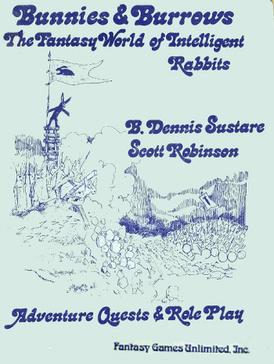
Bunnies & Burrows (B&B) is a role-playing game (RPG) inspired by the 1972 novel Watership Down. Published by Fantasy Games Unlimited in 1976, the game centered on intelligent rabbits. It introduced several innovations to role-playing game design, being the first game to encourage players to have non-humanoid roles, and the first to have detailed martial arts and skill systems. Fantasy Games Unlimited published a similar second edition in 1982. Frog God Games published a revised third edition in 2019 from the original authors. The game was also modified and published by Steve Jackson Games as an official GURPS supplement in 1992.

Steve Jackson Games (SJGames) is a game company, founded in 1980 by Steve Jackson, that creates and publishes role-playing, board, and card games, and the gaming magazine Pyramid.
A fighting game is a genre of video game that involves combat between two or more characters. Fighting game combat often features mechanics such as blocking, grappling, counter-attacking, and chaining attacks together into "combos". Characters generally engage in battle using hand-to-hand combat—often some form of martial arts. The fighting game genre is related to, but distinct from, the beat 'em up genre, which pits large numbers of computer-controlled enemies against one or more player characters.
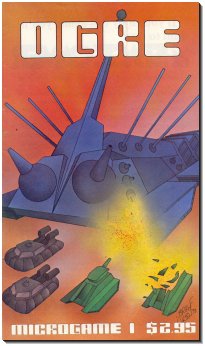
OGRE is a science fiction board wargame designed by the American game designer Steve Jackson and published by Metagaming Concepts in 1977 as the first microgame in its MicroGame line. When Steve Jackson left Metagaming to form his own company, he took the rights to OGRE with him, and all subsequent editions have been produced by Steve Jackson Games (SJG).

G.E.V. is a science fiction board wargame that simulates combat in the near future between supertanks and other futuristic weaponry. The game was designed by American game designer Steve Jackson as a sequel to his Ogre board game when he was working for Metagaming Concepts. When Jackson left Metagaming to form his own company, he took the rights to both G.E.V. and Ogre with him, and all subsequent editions have been produced by Steve Jackson Games.
Gun fu, a portmanteau of gun and kung fu, is a style of sophisticated close-quarters gunfight resembling a martial arts battle that combines firearms with hand-to-hand combat and traditional melee weapons in an approximately 50/50 ratio. It can be seen in Hong Kong action cinema, and in American action films influenced by it.

Nekketsu Kōha Kunio-kun, released as Renegade in the West, is a beat 'em up video game developed by Technōs Japan and distributed by Taito for the arcades in 1986. In the original Japanese version Nekketsu Kōha Kunio-kun, the game revolves around a high-school delinquent named Kunio-kun who must stand up against a series of rival gangs frequently targeting his classmate Hiroshi. In the Western version Renegade, the player controls a street brawler who must face four different gangs in order to rescue his girlfriend being held captive by a mob boss.

Jackie Chan's Action Kung Fu is an action platform video game developed by Now Production and published by Hudson Soft. It was released for the Nintendo Entertainment System in 1990 and for the TurboGrafx-16 in 1991.
Bruceploitation is an exploitation film subgenre that emerged after the death of martial arts film star Bruce Lee in 1973, during which time filmmakers from Hong Kong, Taiwan and South Korea cast Bruce Lee look-alike actors ("Lee-alikes") to star in imitation martial arts films, in order to exploit Lee's sudden international popularity. Bruce Lee look-alike characters also commonly appear in other media, including anime, comic books, manga, and video games.
Metagaming Concepts, later known simply as Metagaming, was a company that published board games from 1974 to 1983. It was founded and owned by Howard Thompson, who designed the company's first game, Stellar Conquest. The company also invented Microgames and published Steve Jackson's first designs, including Ogre, G.E.V. and The Fantasy Trip.

Melee is a board wargame designed by Steve Jackson, and released in 1977 by Metagaming Concepts. In 2019, Melee was revived and re-released by Steve Jackson Games.
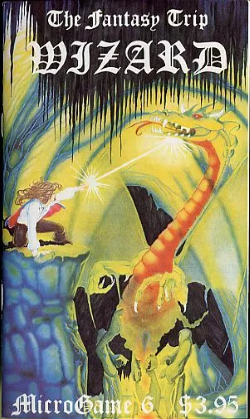
Wizard is a board game system of medieval fantasy magical combat published by Metagaming in 1978 that was designed to complement the previously published Melee, a system of melee combat rules. Forty years later, Wizard was revived and re-released by Steve Jackson Games.

A pocket box is a small box or pocket-sized container, so named to emphasise its portability.

Robots! is a microgame published by Task Force Games in 1980 in which players fight each other using combat robots.

Titan Strike!, subtitled "Battle for the Moon of Saturn," is a science fiction board wargame published by Simulations Publications, Inc. (SPI) in 1979 that is set on Titan, one of Saturn's moons.
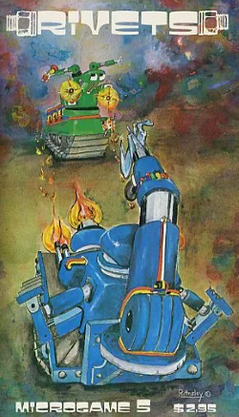
Rivets is a post-apocalyptic board wargame published by Metagaming Concepts in 1977.

Ram Speed, subtitled "Naval Warfare in the Bronze Age", is a two-player microgame published by Metagaming Concepts in 1980 that simulates naval combat between galleys in the Mediterranean during the Bronze Age when the preferred method of attack was ramming a ship.
Raid on Iran is a 1980 board game published by Steve Jackson Games.

Grav Armor is a science fiction tank combat board game published by Heritage Models in 1982.
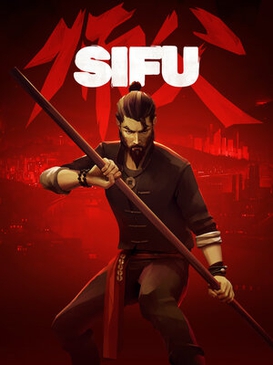
Sifu is a 2022 beat 'em up game developed and published by Sloclap. Set in modern-day China, players control the child of a martial arts school's sifu (master) who seeks revenge on those responsible for their father's death. Every time the protagonist dies, they are resurrected by a magical talisman and age up, gaining access to more powerful attacks but reducing their health. When the player character becomes too old, they can die permanently, in which case players must restart the level from the beginning and from the same age as their initial attempt.